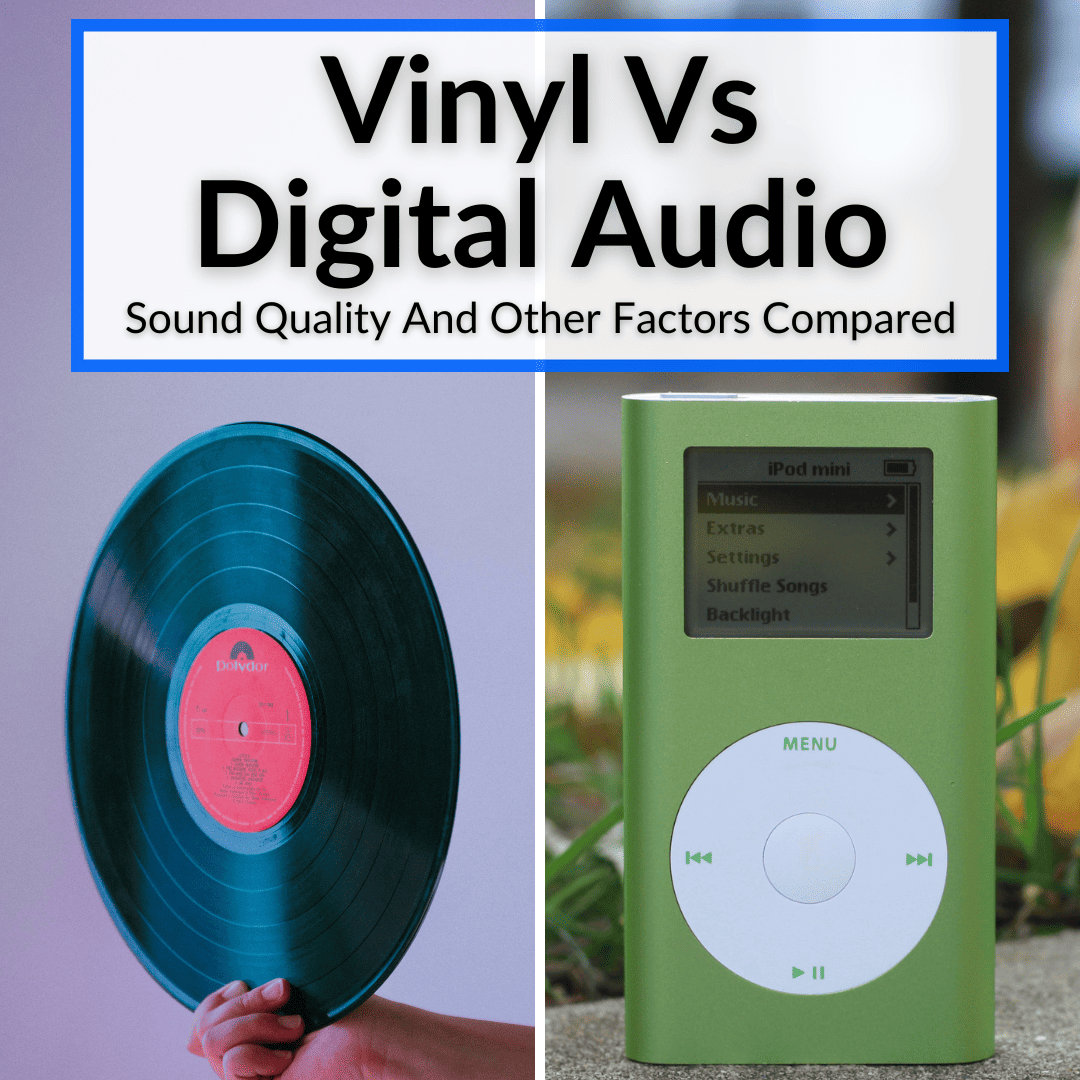
Even though this is a site about vinyl record players, we’re not going to trash digital formats.
We’re not even going to conclude that vinyl vs digital audio is better.
Or worse.
The truth is: both formats have major advantages.
We’re going to take a close look at both and help you figure out which format is better for you and your musical tastes.
Contents
Vinyl Vs Digital Audio
We will begin our comparison on digital music formats vs the vinyl format, by looking at each individually, before comparing them directly. We will finish with the major advantages of each, to help you decide which format is right for you.
The Vinyl Format
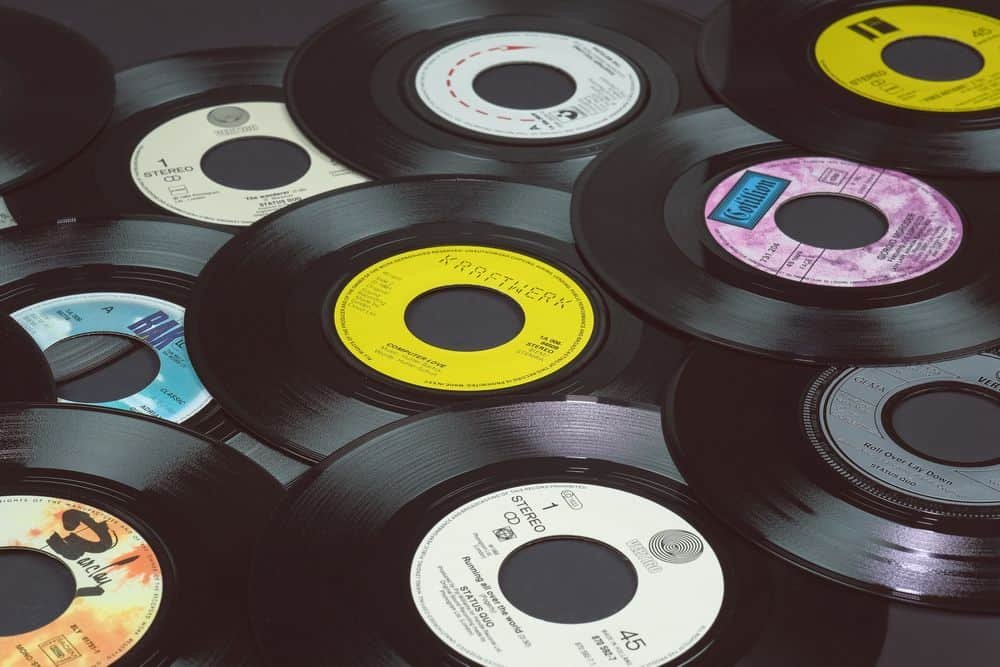
Vinyl records are an older analog format for storing and playing audio that is going through a resurgence in popularity. The records consist of a disc made of polyvinyl chloride (PVC) with a spiral groove etched into its surface.
A thin diamond-tipped stylus mounted on a turntable arm reads the groove, converting the physical variations in the groove into electrical signals that are then amplified and played through speakers.
Vinyl records replaced the original shellac records. They offer a unique and tangible experience, with many audiophiles preferring the “warmer” sound of vinyl over newer digital formats.
The Digital Audio Format
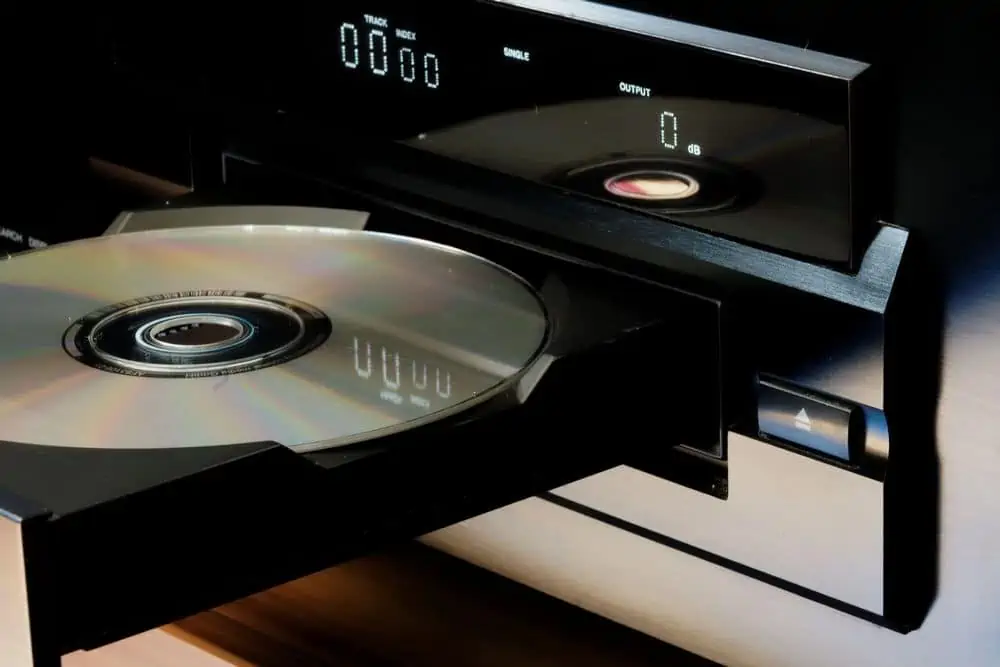
Digital audio formats represent sound using a series of ones and zeros. This allows for more efficient storage, transmission, and manipulation of the audio data. There are various digital music formats, each with its own characteristics:
- CDs (Compact Discs): CDs are physical discs that store audio data digitally, offering good sound quality but limited capacity. The first commercially available compact disc player was released in October 1982 in Japan. CDs became the most popular way for people to consume music before MP3 files started to appear in the early 1990s. See our vinyl and CD comparison for more.
- MP3 Files: MP3s are compressed digital audio files that became popular for their small size and portability. As compressed files, they sacrifice some audio quality to a certain degree, but their convenience outweighed this for the average consumer.
- Lossless Files (FLAC & WAV): FLAC and WAV are uncompressed digital audio files that preserve the original sound quality, offering high fidelity, but larger file sizes, than MP3 files.
- Streaming Services: As the newest form of digital audio, streaming services offer access to vast libraries of music online. The various platforms that offer streaming services typically require a monthly or annual subscription fee for unlimited and ad-free listening.
Similarities Between Vinyl And Digital
Despite their differences, vinyl and digital formats share some key similarities. Both vinyl and digital formats aim to represent the original sound waves as accurately as possible, and both can deliver high-quality audio.
While technical specifications differ, both vinyl and high-fidelity digital formats (like lossless FLAC files) have the potential to produce excellent sound The choice between the two often comes down to personal preference.
Both formats are still popular today, with extensive libraries catering to diverse musical tastes being available in both analog and digital formats. While the two formats share broad similarities, there are also significant differences between vinyl and digital audio in terms of how they capture, store, and reproduce sound.
Differences Between Vinyl And Digital Audio

While both vinyl and digital audio offer ways to experience your favorite music, they cater to different preferences and priorities, due to their differing characteristics.
Tangibility And Ownership
Vinyl records provide a tangible object to own, complete with artwork, liner notes, and the physical act of playing the record. This experience fosters a deeper connection with the music compared to digital formats, where ownership is often less tangible, relying on online accounts and subscriptions for access to your music library.
Sound Quality
Vinyl offers a “warmer” sound, due to the continuous analog representation of the sound waves. However, vinyl records are prone to pops, clicks, and surface noise due to physical imperfections and wear and tear with repeated playback.
Digital audio, particularly in lossless formats, can achieve a wider dynamic range and potentially higher fidelity. However, compressed digital formats like MP3 files can lose some detail and sound quality due to the removal of some audio data.
Convenience
Vinyl is less convenient, because you also need a turntable and speakers for playback. But vinyl does provide a more ritualistic listening experience, and many prefer the more immersive nature of vinyl over more modern digital formats.
Digital audio, on the other hand, is highly portable and convenient. Music is readily accessible on various devices, such as smart phones and online platforms, allowing for easy on-demand listening. With digital audio, you can, quite literally, carry your entire music library with you in your pocket.
Cost
On the whole, vinyl records are typically more expensive per album than digital downloads or streaming subscriptions. Digital options can be more cost-effective, especially with modern streaming services offering unlimited access to vast and varied music libraries for a reasonable monthly fee.
Advantages Of Vinyl
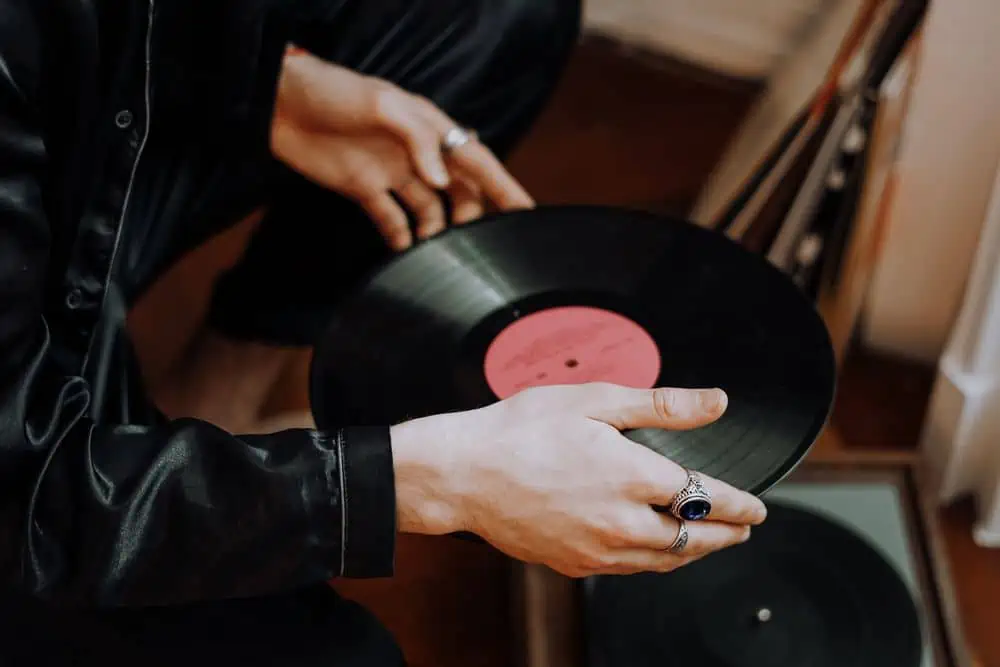
Vinyl offers some key advantages over digital audio formats. Let’s take a look.
Analog Sound Quality
Many audiophiles argue that vinyl records provide a warmer, richer, and more authentic sound than digital music. Vinyl’s analog format captures the nuances and imperfections of the original recording, which some listeners find more pleasing and immersive.
Physicality And Tangibility
Vinyl records offer a physical and tactile experience that digital music lacks. The act of handling and playing a vinyl record, carefully placing the needle on the groove, and flipping the record creates a unique and nostalgic connection with the music. The larger album artwork and liner notes also add to the overall experience.
Ownership And Control
When you purchase vinyl records, you have complete control over your music library. Unlike digital music, which can be subject to format changes, software updates, or removal from streaming services, vinyl records are physical objects that you can keep and enjoy indefinitely. Vinyl records also offer the possibility of being converting to digital formats if desired.
Advantages of Digital Audio

Digital audio formats have their own advantages, as well. In fact, for most, they easily outweigh the advantages of vinyl.
Portability And Convenience
Digital music is easier to store, access, and transport on various devices such as smartphones, tablets, and computers. With digital music, you can carry your entire music library with you wherever you go, making it convenient for travel and on-the-go listening. Additionally, you can stream digital music from online platforms, providing instant access to a vast collection of songs on the fly.
Durability And Accessibility
Digital music files do not degrade over time or with repeated playback, unlike vinyl records. They are not susceptible to scratches, warps, or wear and tear.
Digital music is also easy to copy, back up, and share without any loss in quality. Also, digital music is readily available for purchase or streaming from online platforms, eliminating your need to search for, and buy, physical copies.
Wide Range Of Formats And Sound Quality
Digital music formats offer a wide range of options for sound quality, including lossless formats like FLAC and high-quality streaming services. This allows you to choose the level of audio fidelity that suits you preferences and equipment. You can also easily convert digital music to different formats or resolutions to accommodate your specific playback devices or storage requirements.
Instant Access To A Vast Music Library
Digital streaming platforms provide access to an extensive catalog of songs, albums, and genres from various artists and eras. Streaming services offer personalized recommendations, curated playlists, and the ability to discover new music easily. This vast music library is constantly updated, ensuring that you have the latest releases and a diverse range of music at your fingertips.
Integration With Digital Technologies
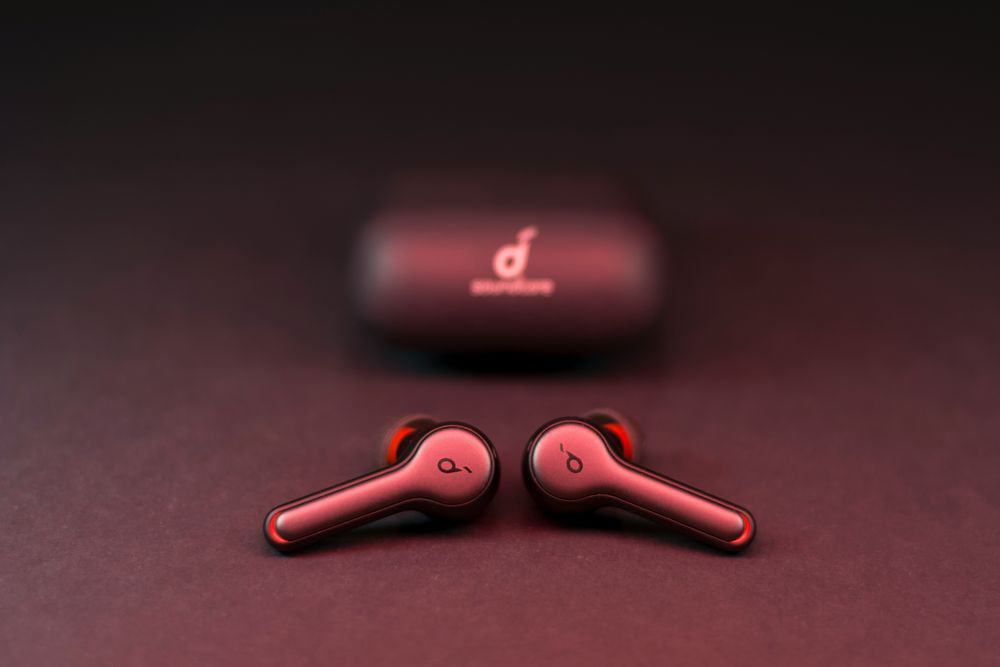
Digital music formats also seamlessly integrate with other digital technologies and services. You can use voice assistants, smart speakers, and wireless audio systems to control and stream digital music effortlessly.
With digital formats, you can also easily synchronize your library across multiple devices, allowing for a seamless listening experience wherever you happen to be.
Vinyl Vs Digital Music: Final Thoughts
In the end, neither vinyl nor digital comes out ahead. The two are very different and this comparison of vinyl vs digital audio makes clear.
Which format is best very much depends on you. That’s why we wanted to stay completely neutral and simply lay out the ficts, so you can use this information to make the right decision for you.
After reading this article, I feel like getting some new L.P.’s and getting out the turntable! Thanks, good article.
Nice comparison, but lacks of data/numbers, like dynamic range, frequency response, signal-noise-ration.
Is it because with those numbers the one side is in favor?